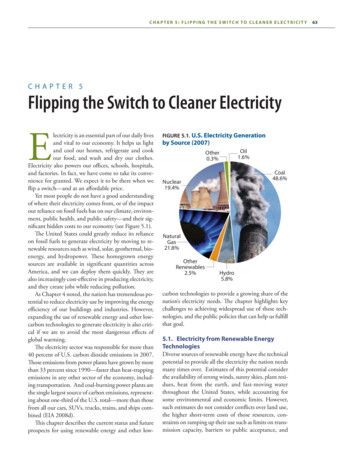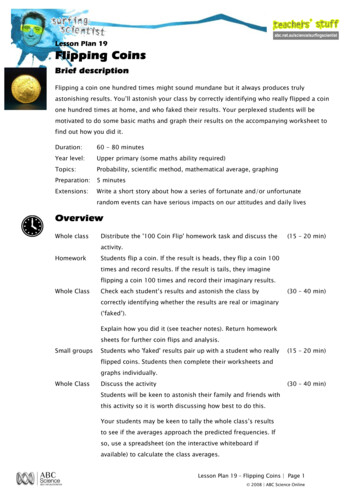
Transcription
Chapter 5: Flipping the switch to Cleaner Elec tricit yChapter 5Flipping the Switch to Cleaner ElectricityElectricity is an essential part of our daily livesand vital to our economy. It helps us lightand cool our homes, refrigerate and cookour food, and wash and dry our clothes.Electricity also powers our offices, schools, hospitals,and factories. In fact, we have come to take its convenience for granted. We expect it to be there when weflip a switch—and at an affordable price.Yet most people do not have a good understandingof where their electricity comes from, or of the impactour reliance on fossil fuels has on our climate, environment, public health, and public safety—and their significant hidden costs to our economy (see Figure 5.1).The United States could greatly reduce its relianceon fossil fuels to generate electricity by moving to renewable resources such as wind, solar, geothermal, bioenergy, and hydropower. These homegrown energysources are available in significant quantities acrossAmerica, and we can deploy them quickly. They arealso increasingly cost-effective in producing electricity,and they create jobs while reducing pollution.As Chapter 4 noted, the nation has tremendous potential to reduce electricity use by improving the energyefficiency of our buildings and industries. However,expanding the use of renewable energy and other lowcarbon technologies to generate electricity is also critical if we are to avoid the most dangerous effects ofglobal warming.The electricity sector was responsible for more than40 percent of U.S. carbon dioxide emissions in 2007.Those emissions from power plants have grown by morethan 33 percent since 1990—faster than heat-trappingemissions in any other sector of the economy, including transportation. And coal-burning power plants arethe single largest source of carbon emissions, representing about one-third of the U.S. total—more than thosefrom all our cars, SUVs, trucks, trains, and ships combined (EIA 2008d).This chapter describes the current status and futureprospects for using renewable energy and other low-Figure 5.1. U.S. Electricity Generationby Source Gas21.8%OtherRenewables2.5%Hydro5.8%carbon technologies to provide a growing share of thenation’s electricity needs. The chapter highlights keychallenges to achieving widespread use of these technologies, and the public policies that can help us fulfillthat goal.5.1. Electricity from Renewable EnergyTechnologiesDiverse sources of renewable energy have the technicalpotential to provide all the electricity the nation needsmany times over. Estimates of this potential considerthe availability of strong winds, sunny skies, plant residues, heat from the earth, and fast-moving waterthroughout the United States, while accounting forsome environmental and economic limits. However,such estimates do not consider conflicts over land use,the higher short-term costs of those resources, constraints on ramping up their use such as limits on transmission capacity, barriers to public acceptance, and63
64U n i o n o f C o n c e r n e d Sc i e n t i s t s : C l i m at e 2 0 3 0other hurdles. Those factors will limit how quickly andto what extent the nation taps the full potential of renewable resources to produce electricity.Several renewable energy technologies are availablefor widespread deployment today, or are projected tobecome commercially ready in the next two decades.In fact, in 2007 developers installed more than 8,600megawatts of capacity for generating electricity fromrenewable sources (excluding conventional hydroelectric power)—topping new capacity from fossil fuels forthe first time (EIA 2009a). And developers installedeven more capacity to produce electricity from renewable sources in 2008. This section describes this recentprogress as well as future prospects for the most promising renewable energy technologies.5.1.1. Types of Renewable Technologies5.1.1.1. Wind PowerThe United States currently generates nearly half of its electricityfrom coal, the most carbon-intensive energy source. Accelerating energyefficiency and the adoption of carbon-free renewable energy technologiessuch as wind and solar is needed to cut emissions and create savingsfrom the electricity sector.Renewable energy can create more jobs than fossil fuels because a largershare of renewable energy expenditures go to manufacturing, installation,and maintenance—all of which are typically more labor-intensive thanmining and transporting fossil fuels. The U.S. wind industry created35,000 jobs in 2008 alone.Wind turbines convert the force of moving air intoelectricity. Like an airplane, the wind turns the bladesusing lift. Most modern wind turbines have three bladesrotating around a horizontal axis. Smaller wind turbines used by homes, farms, and businesses range insize from a few hundred watts to 100 kilowatts or more.Larger wind turbines used for utility-scale generationrange in size from about 500 kilowatts to more thanthree megawatts, have blades up to 52 meters long, andare mounted on towers up to 100 meters high.Wind power is one of the most rapidly growingsources of electricity in the world—having increasedby about 30 percent per year, on average, over the pastdecade (GWEC 2008). Developers installed more windpower over the past two years than in the previous 20.In 2008 the United States surpassed Germany to become the global leader in installed wind capacity, followed by Spain, India, and China. U.S. wind capacitygrew by a record 5,250 megawatts in 2007, and 8,545megawatts in 2008. This represented 42 percent of allnew capacity for generating electricity in the country(AWEA 2009a).As of March 2009, the United States had more than28,000 megawatts of wind power capacity in 36 states(see Figure 5.2). Texas (7,900 megawatts) and Iowa(2,900 megawatts) have surpassed California (2,600megawatts) to become the national leaders, followedby Minnesota, Washington, Colorado, Oregon, NewYork, and Kansas, which have more than 1,000 megawatts each (AWEA 2009b).Wind power has been one of the bright spots in thestruggling U.S. economy. According to the American
Chapter 5: Flipping the switch to Cleaner Elec tricit yFigure 5.2. Installed Wind Power Capacity E153KS1,014OK831TX7,907HI63AR 1MI129OH7INIL915 531MO163VTNH 25NY 6MA 51,261CTRI 1PANJ 8361KYWV330 VANCTN 001,000–10,000Source: AWEA 2009b.Wind Energy Association, the industry now employsabout 85,000 people, and added 35,000 new jobs lastyear alone. Developers invested some 27 billion inU.S. wind power over the past two years—much inagricultural and other rural areas. U.S. manufacturingof wind turbines and their components has also greatlyexpanded, with more than 70 new facilities opening,growing, or announced in 2007 and 2008. The industry estimates that these new facilities will create 13,000high-paying jobs, and increase the share of domestically made components from about 30 percent in 2005to 50 percent in 2008 (AWEA 2009b).Other countries and several U.S. states are alreadyrelying on wind power to provide significant percentages of their electricity needs. In 2007, for example,wind power supplied more than 20 percent of electricity in Denmark, 12 percent in Spain, 9 percent in Portugal, 8 percent in Ireland, and 7 percent in Germany(Wiser and Bolinger 2008). Wind also provided an estimated 7.5 percent of electricity generated in-state inMinnesota and Iowa; 4–6 percent in Colorado, SouthDakota, Oregon, and New Mexico; and 2–4 percentin 13 other states (Wiser and Bolinger 2008). Manyof these states have committed to producing up to 25percent of their electricity from wind and other renewable energy sources.A comprehensive study by the U.S. Departmentof Energy (EERE 2008) found that wind power hasthe technical potential to provide more than 10 timestoday’s U.S. electricity needs (see Table 5.1). That studyalso showed that expanding wind power from providing a little more than 1 percent of U.S. electricity in2007 to 20 percent by 2030 is feasible, and would notaffect the reliability of the nation’s power supply.Achieving that target would require developing nearly300,000 megawatts of new wind capacity, including50,000 megawatts of offshore wind.The DOE study found that, by 2030, that level ofwind power would: Create more than 500,000 new U.S. jobs Displace 50 percent of the natural gas used to produce electricity, and reduce the use of coal by 18percent, restraining rising fuel prices and stabilizingelectricity rates Reduce global warming emissions from power plantsby 825 million metric tons (20 percent) Reduce water use in the sector by 8 percent, saving4 trillion gallons Cost 2 percent more than investing in new coal andnatural gas plants—or 50 cents per month perhousehold—including transmission costs but notfederal incentives or any value for reducing carbonemissions65
66U n i o n o f C o n c e r n e d Sc i e n t i s t s : C l i m at e 2 0 3 0Box 5.1.Succ e s s S t o r yThe Little Country that CouldChildren’s tales don’t often figure in grown-up discussions of energy policy, but Denmark’s progress intapping wind energy is reminiscent of The Little EngineThat Could.Denmark’s story begins in 1973, the year OPEC (theOrganization of Petroleum Exporting Countries) embargoed oil exports, creating debilitating shortages and skyrocketing prices. At that time Denmark relied on oil toproduce 80 percent of its electricity. For the next fewDomestic investment in windhas made Denmark a globalleader in turbine manufacturing.The industry accounts for roughly20,000 jobs in Denmark—and4 percent of its industrialproduction.years that country, much like the United States and otherdeveloped nations, invested in energy efficiency and alternative energy to prevent such a situation from occurring again.When oil prices plummeted in the 1980s, however,the Danish and U.S. governments responded very differently. The United States stopped developing approachesto reducing its dependence on oil, but the Danish government continued to encourage the development ofnew energy sources and nascent technologies. Denmarkreaps the benefits today as a net exporter of energy—a high percentage of which is carbon-free.Denmark relied on a suite of policies to transform itseconomy into a much leaner, greener, and more secureone. Although it expanded development of conventionalfuels off its coasts, Denmark focused principally on reducing demand for electricity and heat. The country steppedup its energy efficiency by insulating existing buildings,enacting stringent codes for new buildings and appliances, and relying on highly efficient combined-Turbines located in the high-speed wind areas off the coastof Denmark generate large amounts of electricity.heat-and-power plants to provide both electricity andheat. The primary power plant serving Copenhagen, forexample, boasts an efficiency of more than 90 percent,compared with an average efficiency rate of 33 percentfor a typical U.S. coal plant (Freese, Clemmer, and Nogee2008).Denmark fostered renewable energy as well, andtoday renewables supply 27 percent of the country’selectricity—most of it from wind (Ministry of Climate andEnergy 2008). With fewer than 70 wind turbines in 1980,the nation now has more than 5,000 providing 3,135
Chapter 5: Flipping the switch to Cleaner Elec tricit ymegawatts of capacity—enough to power morethan 1.6 million typical American households(DWEA 2009).Consistent, long-term policies encouragingthe development of wind energy helped Denmark become a global leader. The governmentspurred investment in wind power by providingincentives that covered 30 percent of the costsof installing turbines until 1990. Denmark alsorequired utilities to buy wind power at a fixedprice until 1999. Although at that point the country required customers to pay any added costs ofwind power, the government mandated thatutilities provide 10-year fixed-rate contracts forwind developers, which helped them secureinvestment financing. Wind power also benefited from priority access to the electricity grid(GAO 2006).This energy transformation helped Denmarkexpand its economy while reducing carbonemissions. Domestic investment in wind hasmade Denmark a global leader in turbine manufacturing. Vestas and Siemens Wind Power dominate global wind sales, and the industry accountsfor roughly 20,000 jobs in Denmark—and 4 percent of its industrial production. While the economy has grown by roughly 75 percent in 25years, energy consumption has remained stable,and the country has cut its carbon emissions inhalf since 1980 (Danish Energy Agency 2008;Ministry of Climate and Energy 2008).Although Denmark is obviously much smaller than the United States, and its energy needsare much lower, the Danes have proved beyonda doubt that national foresightedness and perseverance—combined with smart policies andindustrial innovation—can produce an extraordinary shift in a country’s energy profile. TheUnited States could learn much from the example of “the little country that could”—and did!Growing interest in wind power is evident in the factthat at the end of 2007, developers of more than225,000 megawatts of wind power capacity wereseeking to connect with the transmission grid in 11regions (Wiser and Bolinger 2008). This representsnine times the nation’s installed wind capacity, roughlyhalf of all generating capacity in transmission queues,and twice as much capacity as natural gas, the nextlargest resource. Although many of these projects maynot be built, many are in the planning phase.While developers have so far sited all U.S. windprojects on land, they have shown considerable interest in developing offshore wind. At the end of 2007,seven U.S. states had seen active proposals for installing nearly 1,700 megawatts of offshore wind power(see Table 5.2). Developers are proposing to build mostof these facilities off the Atlantic coast in the Northeast, close to population centers, where power is mostneeded. However, projects are also being consideredoff the Southeast and Texas coasts, and in the GreatLakes (Wiser and Bolinger 2008).Wind power can provide an important economic boostto farmers. Large wind turbines typically use less thanhalf an acre of land, including access roads, so farmers cancontinue to plant crops and graze livestock right up to thebase of the turbines (as shown on this Trimont, MN, farm).67
68U n i o n o f C o n c e r n e d Sc i e n t i s t s : C l i m at e 2 0 3 0Table 5.1. Technical Potential for Producing U.S. Electricity from Renewable watts)ElectricityGeneration(billion kilowatt-hours)RenewableElectricity Generationas Percent of 2007Electricity UseLand-Based8,00024,528591%Shallow Offshore2,0007,008169%Deep ed Photovoltaics1,0001,75242%Concentrating Solar Power6,87716,266392%Subtotal7,87718,018434%Energy Crops8358414%Agricultural Residues11480119%Forest Residues332316%Urban Residues151043%Landfill Enhanced Geothermal Systems5184,08498%Co-Produced with Oil and Gas443478%5954,691113%Existing Conventional772596%New Conventional622185%Wave902606%Hydrokinetic %Renewable alHydropowerSubtotalTotalSources: See Appendix D online.
Chapter 5: Flipping the switch to Cleaner Elec tricit y5.1.1.2. Solar PowerOur analysis included two main technologies for usingsolar power to supply electricity: photovoltaics (PV) andconcentrating solar power (CSP). Both have been usedto generate electricity for decades, though recent technological improvements and strong policy incentives havedramatically accelerated their growth. In 2007, global PVinstallations expanded by 62 percent from the previousyear (Solarbuzz 2008). And after two decades of very littleactivity, the CSP market is also quickly gaining steam.Photovoltaics, or solar cells, use semiconductingmaterials to convert direct sunlight to electricity. Most PVcells are made with silicon, the same material used to manufacture computer chips, although manufacturers are usingnew materials to make some PV cells. PV cells are often usedin rooftop solar energy systems, and to power remote,off-grid applications. However, power producers have alsorecently shown interest in developing multi-megawatt PVprojects that would connect to the transmission grid.CSP typically works by concentrating direct sunlighton a fluid-filled receiver. This heated fluid then drives aturbine to produce electricity. CSP is most often used inlarge, utility-scale plants that are far from urban areas yetconnected to the transmission grid. Most existing CSPplants rely on curved (parabolic) mirrors to focus solarradiation. However, a number of companies are developing large CSP plants that use “power towers” to collectsolar energy from ground-mounted heliostats—or slightlycurved mirrors—and concentrate solar radiation ondistributed receivers.The technical potential of U.S. solar power is huge.PV panels installed on less than 1 percent of the U.S. landHomes that use solar panels and energy efficiency are notonly sustainable but also affordable. The Make It Right project(www.makeitrightnola.org), which is helping to rebuild NewOrleans homes destroyed by Hurricane Katrina, showcasesdesigns that put low electricity bills within everyone’s reach.Table 5.2. Proposed U.S. OffshoreWind Projects (2007)StateProposed Capacity(megawatts)Massachusetts783New Jersey350Delaware200New York160Texas150Ohio20Rhode Island20Georgia10Total1,693 MWNote: The 450 megawatt project in Delaware was reduced to 200megawatts and a 20 megawatt project in Rhode Island was added.Source: Wiser and Bolinger 2008.area could generate the equivalent of the country’sentire annual electricity needs, as could CSP plantscovering a 100-square-mile area.The southwestern United States—with its ariddeserts and minimal cloud cover—is home to someof the world’s best solar resources. The NationalRenewable Energy Laboratory (NREL) estimatesthat CSP has the potential to generate 7,000 gigawatts of electricity in the Southwest—after screening out urban centers, national parks, other protectedareas, and lands with slopes greater than 1 percent(SETP 2007). This potential is roughly 10 times thenation’s entire current capacity to generate electricity. NREL also identified optimal locations for200 gigawatts of CSP, taking into account proximityto existing transmission lines, and estimated that thenation could build as much as 80 gigawatts of CSPcapacity by 2030 (see Figure 5.3).Although the United States lags behind othercountries in tapping CSP, the industry is poised forsignificant growth because of new state and federalpolicies. In the Economic Stimulus Package of October 2008 Congress extended the 30 percent investment tax credit for solar energy projects for eightyears. Several states have also adopted renewableelectricity standards and financial incentives to expand the share of solar in their electricity mix. Andseveral utilities have signed contracts to develop69
70U n i o n o f C o n c e r n e d Sc i e n t i s t s : C l i m at e 2 0 3 0Box 5.2.Succ e s s S t o r ySurprises in the DesertDeserts have long been imagined as hot and desolate landscapes—but their reputations have beenburnished recently. Deserts are now more likely to beappreciated as unique and often surprisingly diverseenvironments. Approximately 40 miles southeast of LasVegas, the desert does indeed hold a most surprising find:a power plant generating electricity from the sun.When most people think of solar energy, images ofphotovoltaic panels on rooftops come to mind. Butthere is another kind: concentrated solar power (CSP),which uses mirrors to collect and transform the heat ofthe sun into steam, which spins a generator. CSP’s relatively simple approach enables it to produce renewable electricity on a scale comparable to conventionalcoal and natural gas plants.The third largest solar power plant in the world—and the largest CSP plant in the United States—was built outside Boulder City, NV, in June 2007. TheNevada Solar One plant uses 760 long, tubular mirrors(or parabolic troughs) to concentrate the sun’s energyon solar receivers.40 The receivers heat a mineral oilfluid to 734 F, which turns water into steam thatpowers a turbine to generate electricity. The solar receivers track the sun’s movement, allowing the facilityto produce electricity during all of the hours in whichthe sun is brightest.The solar fields themselves occupy an area roughlythe size of 200 football fields. The plant’s maximumcapacity is 75 megawatts, and it generates about 134million kilowatt-hours of electricity each year—enoughto power the lights, appliances, and electronics in14,000 average U.S. homes. This near-zero-carbon electricity reduces global warming emissions by an amountequivalent to taking 20,000 cars off the road each year.CSP is now sparking a lot of attention. Interest is especially high in the desert Southwest, which containslarge open spaces and some of the world’s best solarresources. This area is also close to some of the country’s largest and fastest-growing population centers. Asof July 2008, the federal Bureau of Land ManagementThe world’s third largest solar power plant sits in theNevada desert, generating clean electricity.had received 125 applications to develop large-scalesolar facilities on public lands (EIA 2008). In Californiaalone, developers have proposed more than 3,500megawatts of CSP projects, which are now under regulatory review (CEC 2008a).Another piece of good news is that the construction of CSP plants creates good jobs. Estimates suggestthat every 100 megawatts of installed CSP capacitycreates 455 temporary construction jobs (Stoddard,Abiecunas, and O’Connell 2006). The Nevada One facility, for example, provided over 800 construction jobsfor about 17 months, and now permanently employsapproximately 30 people (ACCIONA 2009).As with any renewable energy technology, CSPmust be built in an environmentally responsible manner. Because many CSP projects are sited in desertareas, developers must avoid disrupting the naturalhabitats of unique desert plants and animals, and minimize the water used for cooling. But if careful policiesguide environmentally responsible CSP development,our deserts may continue to be surprising places—where catclaw acacia and solar power plants alikedelight the occasional visitor.40 The Nevada plant is owned by ACCIONA Solar Power, a subsidiary of ACCIONA Energy. Headquartered in Madrid, Spain, this energycompany develops and manages renewable energy plants and infrastructure projects throughout the world.
Chapter 5: Flipping the switch to Cleaner Elec tricit yFigure 5.3. The Potential of Concentrating Solar PowerDirect NormalSolar 5–7.06.0–5.5TransmissionLinesNote: Potentially sensitive environmental lands, major urban areas, water features, areas with slope 3%, and remaining areas less than1 sq. km were excluded to identify those areas with the greatest potential for development.Source: NREL, July 2007.both distributed and large-scale solar projects. For example, utilities in California and Arizona have contracted for enough new CSP projects to more thantriple existing global capacity.The U.S. solar energy industry employs more than80,000 people and created more than 15,000 jobs inthe last two years. One recent study estimates that theindustry will create 440,000 permanent jobs and spur 325 billion in private investment by 2016, given thefederal investment tax credit (Navigant 2008).5.1.1.3. Geothermal EnergyGeothermal energy—heat from the earth—can be usedto heat and cool buildings directly, or to produce electricity in power plants. Almost all existing geothermalpower plants use hot water and steam from hydrothermal reservoirs in the earth’s crust to drive electric generators. These plants rely on holes drilled into the rock tomore effectively capture the hot water and steam. Muchlike power plants that run on coal and natural gas, geothermal plants can supply electricity around the clock.More than 8,900 megawatts of geothermal capacityin 24 countries now produce enough electricity to meetthe annual needs of nearly 12 million typical U.S.households (GEA 2008a). Geothermal plants produce25 percent or more of the electricity produced in thePhilippines, Iceland, and El Salvador. The United Stateshas more geothermal capacity than any other country,with nearly 3,000 megawatts in seven western states.About two-thirds of this capacity is in California, where43 geothermal plants provide nearly 5 percent of thestate’s electricity (CEC 2008).While geothermal now provides only 0.4 percent ofU.S. electricity, it has the potential to play a much largerrole—thereby reducing carbon emissions and movingthe nation toward a cleaner, more sustainable energysystem. In its first comprehensive assessment in morethan 30 years, the U.S. Geological Survey (USGS) estimated that conventional hydrothermal sources on private and accessible public lands across 13 western stateshave the potential capacity to produce 8,000–73,000megawatts, with a mean estimate of 33,000 megawatts(Williams et al. 2008). State and federal policies arelikely to spur developers to tap some of this potentialin the next few years. The Geothermal Energy Association estimates that 103 projects now under development71
72U n i o n o f C o n c e r n e d Sc i e n t i s t s : C l i m at e 2 0 3 0Figure 5.4. How Advanced Geothermal Systems WorkEnergyConversion SystemHot RockSource: EERE 2008a.Enhanced geothermal systems tap into hot rock at greater depthsthan conventional geothermal systems—approaching the depths ofoil and gas wells—to expand the economically recoverable amountof heat and power stored under Earth’s surface. The Department ofEnergy, several universities, the geothermal industry, and venturecapital firms are collaborating on research and demonstrationprojects to harness the potential of this technology.in the West could provide up to 3,960 megawatts ofnew capacity (GEA 2008b).While most near-term capacity will likely come fromhydrothermal sources, the USGS study also found thatenhanced geothermal systems (EGS) could provide another 345,100–727,900 megawatts of capacity, with amean estimate of 517,800 megwatts (see Table 5.1).That means this resource could supply nearly all oftoday’s U.S. electricity needs (Williams et al. 2008).EGS entails engineering hydrothermal reservoirs inhot rocks that are typically at greater depths below theearth’s surface than conventional sources. Developersdo this by drilling production wells and pumping highpressure water through the rocks to break them up. Theplants then pump more water through the broken hotrocks, where it heats up, returns to the surface as steam,and powers turbines to generate electricity (see Figure5.4). Finally, the water is returned to the reservoirthrough injection wells to complete the circulationloop. Plants that use a closed-loop binary cycle releaseno fluids or heat-trapping emissions other than watervapor, which may be used for cooling (EERE 2008a).The DOE, several universities, the geothermal industry, and venture capital firms are collaborating onresearch and demonstration projects to harness thepotential of EGS. Google.org is playing an especiallyactive role in promoting the technology (Google 2008).Australia, France, Germany, and Japan also have R&Dprograms to make EGS commercially viable.One of the goals of these efforts is to expand theeconomically recoverable resource to depths approaching those used in oil and gas drilling. Depths of sixkilometers (19,685 feet) have enough heat to makegeothermal energy viable in many more areas (see Figure 5.5). The oil and gas industry has already successfully drilled to such depths. Shell Oil holds the record,having drilled to a depth of more than 10 kilometers(33,200 feet) in the Gulf of Mexico in January 2004(GEA 2008c).The Blueprint analysis includes both hydrothermaland EGS technologies.5.1.1.4. BiopowerBiomass is the oldest source of renewable energy, coming into use when our ancestors learned the secret offire. Humans have been burning biomass to make heat,steam, and electricity ever since.The Blueprint analysis considers a wide variety ofbioenergy resources. These include lower-cost biomassresidues from forests, crops, urban areas, the forestproducts industry, and landfill gas, which is mostlyIn the near term, the most cost-effective biopoweroptions for reducing the global warming emissionsassociated with electricity generation are 1) co-firingbiomass with coal, 2) biomass combined heat andpower, and 3) landfill gas. The Grayling power stationin Michigan uses waste wood from local sawmillsand the forest products industry.
Chapter 5: Flipping the switch to Cleaner Elec tricit y73Estimated Earth Temperature at 6 km DepthFigure 5.5. Geothermal PotentialSource: SMU Geothermal Laboratory 2006.methane from decomposing organic matter. Theanalysis also includes crops grown primarily for use inproducing energy, such as fast-growing poplars andswitchgrass (a native prairie grass). The availability andquantity of these resources varies from region to regionbased on many factors, including climate, soils, geography, and population. (For more information, seeAppendix G online.)The Blueprint includes three main approaches tolarge-scale production of electricity from biomass: dedicated biomass power plants, which run solely on biomass; coal plants that burn biomass along with coal;and the use of biomass to produce both electricity andsteam—also know
Chapter 5: Flipping the switCh to Cleaner eleCtriCity 63 C h a p t e r 5 Flipping the Switch to Cleaner Electricity E lectricity is an essential part of our daily lives and vital to our economy. It helps us light and cool our homes, ref










